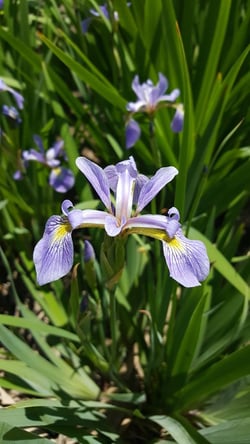 Kentucky landscapes and gardens are filled with flowering perennial plants. Perennials are special plants that come back year after year. Often times they are herbaceous and die back to the ground each winter.
Kentucky landscapes and gardens are filled with flowering perennial plants. Perennials are special plants that come back year after year. Often times they are herbaceous and die back to the ground each winter.
But come spring, they regrow to full size and have profuse blooms – which is why we love them in our gardens. Some perennials stay where we put them, but others spread out with time. This can be a good thing, or it can be a problem depending upon the situation.
When a plant like Liriope spreads it forms a lovely dense groundcover that prevents weeds from sprouting. But other plants, like Obedient Plant, can grow aggressively and crowd-out other plants in the bed. Of course, problems can be avoided by initially choosing the right plant for the right place.
But there are practical opportunities to take advantage of with spreading perennials. By dividing them, you can get essentially free plants.
How to properly handle and divide spreading perennials requires understanding how they grow and spread.
When a plant propagates itself by sending out runners to form clumps and masses, it is called asexual propagation. The plant has essentially made a clone of itself.
Here are the common ways plants make clones of themselves and how they can be divided.
 Rhizomes
Rhizomes
Some plants, like Iris and native Mountain Mint, spread by underground stems which are called rhizomes. A stem will branch out from the mother plant and grow for a time underground and then pop up to make a new plant.
These new plants are easily cut away from the mother plants and already have strong roots systems that helps improve their chances of transplanting success.
Stolons
Strawberries are a great example of a plant that propagates itself through stolons. Stems run along the top of the ground and then root in to make a new plant in places where they touch the ground. When transplanting, make sure the new plant has fully rooted before separating from the mother plant.
Bulbs and Bulblets

Bulblets are easily detached and replanted like a normal bulb. It is best to wait to dig up your bulbs until the above ground portion fully senesces to ensure the energy of the bulbs are recharged for next season.
Other Plants That Can Be Divided
There are other plants that do not naturally make clones of themselves but can still be divided. Ornamental grasses like Switchgrass, or flowers like Peonies can be cut apart to make clones of the mother plants. It is best to wait until plants are a couple years old before dividing them.
In Kentucky, March and April are ideal times for splitting most perennials. As always, consult with a plant professional if you have any questions or concerns about your plants.
Dividing perennials sets up your landscape beds to have a healthy season. It is a budget friendly way to get sparsely planted beds to become fuller at low cost. And the fuller your landscape bed is with desirable plants, the fewer weeds you’ll get. The best time to divide most of your perennials is just as they start to regrow from their winter dormancy.
Let’s talk more about preparing for spring. It’s around the corner!
Call us any time in Lexington at 859-254-0762 or in Louisville at 502-264-0127. Or you can fill out this simple contact form and we’ll get in touch with you.


